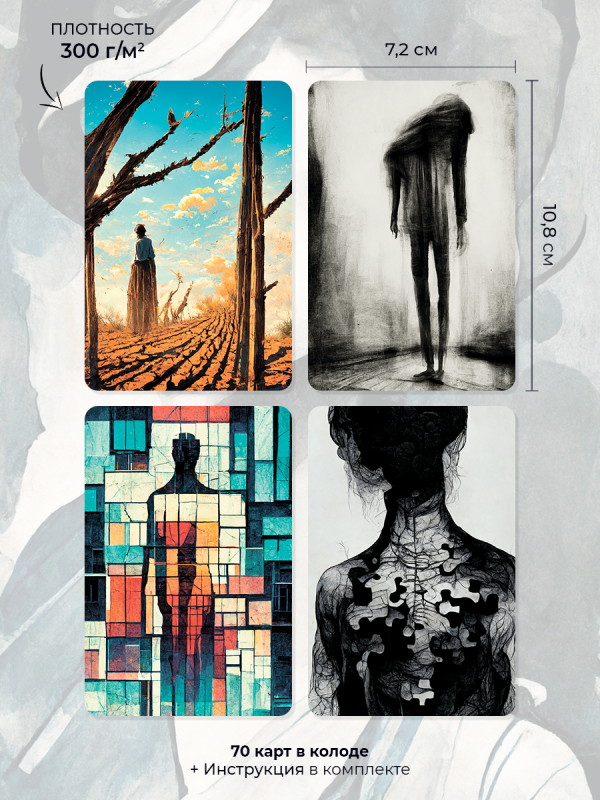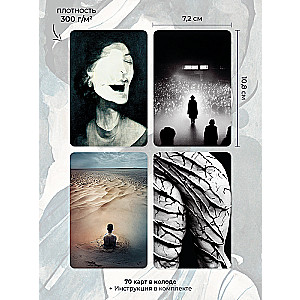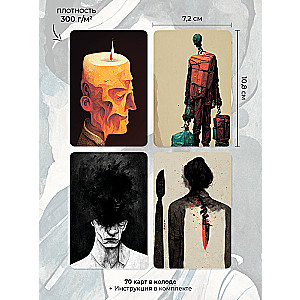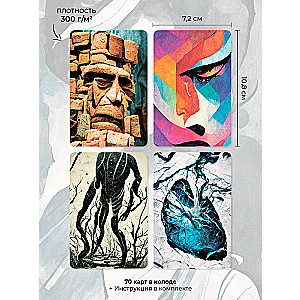Metaphorical Associative Cards "Images of the Symptom"
Contents: 70 cards; instructions; 7 techniques for work as a gift via QR code!
Psychosomatics is the bodily manifestation of a symptom caused by psychological reasons. It is a disturbance of the harmony of the mind, soul, and body.
For example, potential...
causes may include: psychologically traumatic situations, alexithymia, serious resentment, disappointment, suppressed emotions, stress, disruption of close relationships, inner conflict, tension, emotional burnout, codependency, autoaggression, loss, mental pain, disruption of contact with the body, organic speech, unfulfilled need.
"Illness arises at the intersection of three spheres - psychological, physiological, and social" - Franz Alexander.
The emergence of a symptom is a way to adapt to reality.
"As long as you fight the symptom, it will get worse. If you take responsibility for what you do to yourself, for how you create your symptoms, for how you create your illness, for how you create your existence - at the very moment when you establish a connection with yourself - growth and integration begins" - Frederick Perls.
The images in the deck reflect the metaphors of the symptom and what the voice of the soul says, expressed through the body.
To embark on the path of healing, it is important to:
• find the psychological causes of the emergence and maintenance of the illness
• recognize the inner conflict
• understand the function of the symptom
• understand what secondary gains are maintaining the symptom
• realize the message of the symptom
• establish contact with the body and soul
• understand what feelings are "stuck" in the body and how they affect health
• learn to understand and experience your feelings
• see the symptom from another perspective and change your attitude towards it
• gain the readiness to let go of the symptom
• find a constructive solution and satisfy the need
• make a plan of action and implement it in reality.
To assist with these actions, the metaphorical associative cards "Images of the Symptom" were created.
If desired, they can be combined with any portrait, universal, resource, special (for work with psychosomatic symptom) and textual cards.
Methods of working with the associative cards "Images of the Symptom": openly (conscious choice) and closed (intuitively, without looking).
A list of questions that reveal the metaphorical card:
• What is depicted on the card? What is happening?
• What feelings does this image evoke in you?
• What do you dislike about it? Why?
• What do you like about it? Why?
• What specifically caught your attention?
• What do you not want to look at? Why?
• What do you want to do?
• What character is this?
• What does he think?
• What does he feel?
• What qualities does he possess?
• What skills does he have?
• What can you name this picture?
• If this character spoke, what would he say?
• If this character were you, what would you think and feel in this form?
• What colors and shapes are on this card? What feelings do they reflect?
• Name all adjectives that fit this image?
• What details scare you? Why?
• What would you remove from this image? What does the metaphor of what is unnecessary speak about?
• What details do you like? What resource can they reflect?
• What associations arise for you with this image?
• How is what is depicted on the card related to you and your symptom?
• What is the main thing on this card?
• What is happening beyond this card?
• What needs to happen for this image to become harmonious?
• What message does the card carry for you?
• What is important to pay attention to?
• How can this understanding help you?
• What are you willing to do?
If you cannot find the answer using the prepared techniques with the card, you can apply one or more questions from the list to reveal it.
If you use these same questions sequentially while working with one card - they will work as a large complex technique.
This tool is designed for:
psychologists, psychotherapists, specialists from other helping professions, leaders of psychological and transformational games, specialists in working with metaphorical associative cards, people engaged in self-knowledge and self-development.
Techniques for working:
1. «Name of the Disease»
Goal and objectives:
Bring to conscious awareness the connection between the illness and its function in life; give a name to your symptom.
Algorithm:
Think about which symptom you want to work with.
How do you usually name the manifestation of your symptom? What has started again? What hurts? How do you individually name your disease?
Draw one card from the deck with your eyes closed. Describe it.
What clues does the metaphor of this image provide? What associations come to mind?
Imagine that this image is a painting in a gallery. What would it be called?
Is there an understanding of how it relates to psychosomatics? What function does the symptom perform in your life?
Considering your answers, give an expanded title to your symptom. What does it mean to you? Why has it appeared in your life? For what purpose?
2. «Influence of the Symptom»
Goal and objectives:
Realize the influence of the symptom on important areas of life, its function, and the consequences that the illness can lead to if nothing changes.
Algorithm:
Determine which symptom you will be working with.
Draw one card for each question with your eyes closed.
How does the symptom affect my well-being?
How does it affect my personal relationships?
How does it affect my financial situation?
How does it affect my social life?
How does it affect my personal development?
Reveal each image sequentially.
Draw two cards with questions face down:
Who was I before the illness?
Who have I become after it?
Reveal the cards sequentially.
Think: How have you changed since its appearance?
What are the pros and cons of the symptom's emergence in your life?
3. «Causes of Psychosomatics»
Goal and objectives:
Understand what early psychological traumas influenced you, making you susceptible to psychosomatization; recall what period and situation provoked the onset of the illness.
Algorithm:
Name the symptom you will explore.
Draw three cards with your eyes closed. Work with each one sequentially.
Describe the card. What character is it? What does he feel? What does he fear? What limiting beliefs does he have? What is he sure of?
Imagine what could have happened earlier with him that made him look this way? What changed him? What was his childhood like? What psychologically traumatic situations did he experience?
How does all this relate to you? Recall what stressful events you had to endure?
Now, recall the situation that was happening in your life when the symptom appeared? And a little earlier, six months prior? How can this be described? What did you lose?
Make a conclusion. What could be the psychological causes of your symptom's emergence?
Author: MACARDS
Printhouse: MACards
Age restrictions: 12+
ISBN: 9785604833605
Weight: 226 g
ID: 1615442
30 December (Tu)
free
29 December (Mo)
€ 9.99
free from € 80.00
30 December (Tu)
free
29 December (Mo)
€ 9.99
free from € 80.00





















